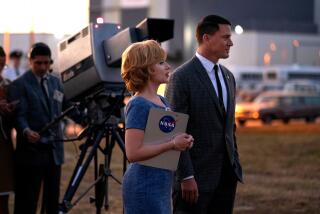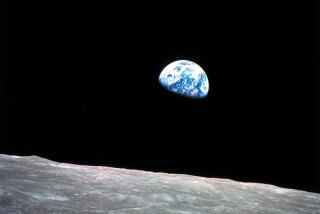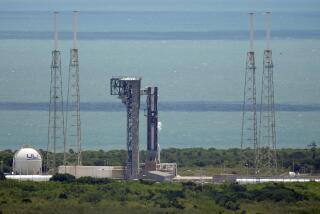Science / Medicine : APOLLO 20 YEARS LATER
Twenty years ago this week, the United Statesâ Apollo 11 spacecraft landed the first humans on the surface of the moon, fulfilling a dream shared by poets and presidents.
That accomplishment stands as one of the great feats of modern science and is one whose legacy continues to be felt today.
âOther than the pyramids, I donât know what other accomplishment by man even compares with it,â said Christopher Kraft, former director of Apollo mission operations.
When Astronaut Neil Armstrong set foot on the moon on July 20, 1969, he did more than fulfill President John F. Kennedyâs bold promise of 1961 to land a man on the moon before the end of the decade. Coming at a time of political and social turmoil, the landing unified a nation and provided some much-needed heroes--most notably the Apollo 11 crew, Armstrong, Edwin E. (Buzz) Aldrin Jr. and Michael Collins.
But there were others among Apolloâs 200,000 scientists, engineers and technicians who were the unknown, unseen heroes. They fought the lesser-known but critical battles of technology at a time when computerization was in its infancy, and they won. If they had not, the mission might have ended in disaster or there might have been no Apollo at all.
Gerry Elverum was one of those people.
In 1961, Elverum was an engineer at TRW in Inglewood designing rocket engines that he hoped would someday be used in space.
The National Aeronautics and Space Administration had already decided to use the Gargantuan Saturn 5 engines to launch Apollo vehicles out of the Earthâs atmosphere, but bringing a manned craft down to the moonâs surface would require the development of an additional engine capable of controlled descent.
Elverum thought he had that engine.
Because it would serve as both a brake and booster for the descent vehicle, Elverumâs design allowed the thrust and direction of the engine to be adjusted by the vehicleâs occupants. Should the need to change landing locations arise midway through descent, the astronauts would be able to modify the speed and trajectory of the craft accordingly.
Although not involved in the original bidding process for the descent engine, Elverum and a team from TRW approached NASA contractors with their plans.
âWe have an idea for how that engine ought to really be made, and we want to talk to you about it,â Elverum told the contractors.
The contractors listened and, based on engine designs Elverum had made for much smaller vehicles and positive test results achieved with their scaled-up versions, eventually awarded TRW the contract for the only engines that have ever landed men on the moon.
âThat was a very intense time period,â recalled Elverum, now a senior propulsion engineer at TRW. âWe were not a known name in propulsion at that time . . . but we submitted a proposal and, lo and behold, we won.â
On the day of the Apollo 11 landing, Elverum and his crew were stationed at a test facility in Bethpage, N.Y., where they monitored a full-scale mock-up of the Apollo lander. Should anything go wrong with the engine during descent, they would be asked to give technical advice to the astronauts in space.
âIn other words, if they were pushing buttons and the engines didnât start, we could in real time look at all the stuff and say, âHere, try this, try that,â â Elverum explained.
The engines performed flawlessly, however, responding on cue, even when Armstrong was forced seconds before touchdown to take manual control of the descent to avoid landing in a boulder field. Toggling the engineâs control switch, a feature which Elverum had included in the design, Armstrong landed the craft safely, away from the lunar boulders. As Armstrong would later comment on the landing, the engine performed without a hitch.
In years to come, the engine would be used successfully for tasks it was never designed to perform, as witnessed in the aborted Apollo 13 moon mission in 1970.
On that mission, an oxygen tank attached to the craftâs service module exploded halfway to the moon, leaving the three astronauts drifting in space. Using the landing vehicle as a lifeboat, however, the astronauts were able to swing around the moon and direct the craft back to Earth, using Elverumâs engine as their only propulsion.
âWhen it was called on, the engine worked. You feel good about that,â Elverum said. âWhen life gets tough, you can always look back and say there was something that worked and we accomplished it.â
If not for the split-second decision of another relatively unknown Apollo 11 player, however, Elverumâs engine might never have had the chance to perform so perfectly in the first place.
Before beginning its final descent to the moonâs surface, the Apollo 11 lander, called Eagle, experienced a series of problems in its communication and navigational systems.
After several hours in orbit around the moon while still attached to the Apollo command module and another period of orbit after separation, âeverything looked fairly OK,â said Steven Bales, who was the missionâs 26-year-old guidance officer stationed back on Earth.
As Eagle circled around from the dark side of the moon, preparing to begin the final descent process, âthe communications were dropping in and out . . . and there were indications, ever so subtle, that possibly the down-range (landing) distance was a little off,â Bales said.
Ground control crews considered the problems manageable, however, and the lander was given permission to begin its descent. But within moments, Bales noticed that Eagleâs navigational computer was registering a descent rate of about 20 feet per second slower than the module was actually traveling.
Had the discrepancy grown to 35 feet per second, it would have disrupted navigation to the point where the descent would have to be aborted altogether, Bales said. But because it remained constant, he was able to give the go-ahead for the process to continue.
But no sooner did that crisis pass than a systems alarm in Eagle began to sound, indicating more trouble with the vehicleâs computer. The alarm, known as a â12 02â warning, showed that because of an informational overload, the computer was not completing some necessary calculations.
âHere we are in the middle of the descent, we had just had a navigational concern and . . . we hear this program alarm. It was really a shock,â Bales said.
By chance, a similar problem had arisen in a simulation of the landing a few weeks earlier, and it had been determined that if the alarms came infrequently enough, the landing would not necessarily have to be aborted. The definition of infrequent, however, was left to the flight controllerâs discretion and a go/no-go decision based on the alarms would essentially be a judgment call.
âSo in a period of about 20 seconds I made up my mind that it was OK to continue,â Bales explained.
Although six more computer alarms cropped up over the next several minutes, Bales stuck by his decision, and after about 15 minutes, he and others back on Earth heard the static-tinged voice of Armstrong announce: âHouston, Tranquility Base here. The Eagle has landed.â
With the thousands of workers involved in the lunar program, it is not surprising that the majority have gone unrecognized. Aldrin himself, though known by millions of Americans as Armstrongâs only companion in the Eagle lander, is destined to be remembered as the second man to set foot on the moon. People âwant to say that (I) feel bad because he went out first, but I think itâs small people who say that,â Aldrin said.
However, he is also the person who called out altitude and directional readings for Armstrong when problems in the Eagleâs navigational computer forced a manual landing. Without that information, such a descent would probably have been impossible and could have ended in tragedy.
Although after touchdown Aldrin followed Armstrong out onto the surface of the moon by less than 20 minutes, it is Armstrongâs name, not Aldrinâs, which comes to mind when recalling the historic landing and subsequent moon walk.
In the years after Apollo 11, Aldrin has acknowledged that he developed a substance abuse problem in coping with the impact of the moon landing on his life and underwent psychiatric treatment for depression related to it. Now recovered, Aldrin said he holds no bitterness about his involvement in the moon program or about the lesser position he held on that mission.
âRight now Iâm very satisfied with my ability to project my talents to be very useful in the space program,â he said.
But like many involved in the Apollo program, Aldrin questions whether future space accomplishments can match Apolloâs intensity and excitement.
âProject Apollo was the single most audacious endeavor in human history,â he wrote several years after the landing. âWhen future generations remember Apollo, just as we now recall the voyages of Columbus . . . they will remember (that) in July, 1969, people like themselves first set foot on the moon.â
More to Read
Sign up for Essential California
The most important California stories and recommendations in your inbox every morning.
You may occasionally receive promotional content from the Los Angeles Times.










